I’m not quite sure what to make of the collection. I know it’s the first of six volumes which will include the entire 80-issue run of James Robinson’s reimagining the concept (plus extras) and I know that it’s the opening chapter of a much more expansive story. And I know that – as a story – it is structured in a much more dynamic and interesting way than most other superhero adventures. But I’m not feeling it. At least not yet.
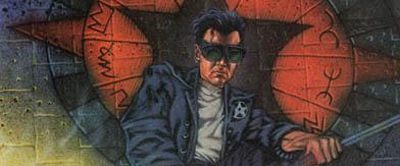
No hero here(o)...
For those unfamiliar with the concept, the Starman is what might be termed a ‘legacy character’ – it’s a title more than an individual that has been passed down through generations. The original Starman – Ted Knight – was a Golden Age hero who has slowly faded from popular consciousness, not having the staying power of some of his other peers. But Starman is very clearly incidental to the story which Robinson seeks to tell here. It could be any other hero and (as Robinson concedes in his on-going afterword) it almost was.
Jack Knight was Ted Knight’s youngest son. He was first introduced in a single page of DC Comics crossover du jour the less-than-memorable Zero Hour. He was present when Ted passed the baton – or in this case ‘cosmic rod’ – to his oldest son, David. Jack has two lines on the page – one expressing concern for his father and the second announcing he “wouldn’t want that gig”. David assures his father that there will always be a Starman. The page is fittingly included as the last extra in this collection.
It looks like Robinson took that page and ran wild with it. Getting 80 issues from that concept may seem a bit much, but Robinson realises how much must have been compressed into that scene. All the family drama, all the legacy, all the weight and responsibility, all their lives until that point. And Robinson allows those concepts room to breath and grow.
The series opens with the assassination of David Knight, the favoured son wearing the Starman costume – with its outdated primary colours and inexplicable headfin. We never even get to see him fly – simply fall as the sniper’s bullet pierces his heart. Though Jack may fight it, Robinson makes it perfectly clear that the role of the Opal City’s hero runs along the standard line of inheritance. It’s time to step up. And though Jack may fight it, we get the sense that there is heroism in his blood. One of the core themes of Robinson’s run is the strange places where we can find heroism (and how hard we try to hide it).
The central theme of the piece (and of the whole collection) is family. Not just the traditional biological family (though that gets its fair share of attention with the Knight family of heroes, the Mist family of villains and the O’Dare family of police officers), but also the families which we create for ourselves through circumstance (later in the collection Ted Knight finds himself serving as surrogate father to Solomon Grundy and a blue alien, and the community of circus folk who settle and form their own community). It seems that we may as well get comfortable with who our family is, because that shapes who we are (as Jack Knight and Nash find out over the run).
It’s often stated that Starman is the superheroic equivalent to Sandman. Both were written by British authors. Both favoured the obscure side of the DC Universe. Both ran a finite length under the same author (both even ended on round numbers). Both mixed arc-based stories in the present with oneshot stories in the past. Both were clearly plotted from the start. Both even featured artwork by Tony Harris. I acknowledge the similarities and I can see them, but I think it’s an unfair comparison to put on any book.
Robinson and Gaiman may both appreciate the more esoteric aspects of storytelling, but Robinson is anchored to comic book conventions in a way that Gaiman wasn’t – he could just let loose and fly. Maybe I will review and revise my observations upon completing the collection, or maybe I won’t.
I greatly enjoy his fascination with the Golden Age – which prefigures the modern fascination with the Silver Age by demonstrated by Grant Morrison’s stint on Batman or Geoff Johns’ stint on Green Lantern – and I appreciate the way that he explores the gap between the near-mythical then and the now. Times change. The world is not such an innocent place as it was when the character originally appeared. Perhaps the best story in the collection – 13 Years Ago: Five Friends – looks at that, with five Golden Age heroes reuniting to square up against a former harmless Flash antagonist during the 1980’s. The once ridiculous Ragdoll has become a leader of a cold-blooded cult preying on the families of Opal City. He isn’t captured with a glib remark or a knowing joke, he instead threatens the families of the heroes confronting him: he will kill their families for their transgression. In more ways than one, the story symbolises the death of the innocence of the Golden Age.
Robinson plays with the superhero narrative. Jack Knight eschews the conventional superhero costume for goggles and a leather jacket (he also eschews the secret identity schtick) – it’s a breath of fresh air. He isn’t a superhero. Yet, at the same time, Nash justifies her crime spree by stating “that’s what archfoes do, isn’t it, after all?” She insists upon a developing antagonistic relationship between them, defined by the conventions of the genre (instructing him to “work at becoming he one, true, best Starman, as I am working at becoming the one true Mist”). Jack is trapped between not wanting to be a conventional superhero, and being forced and moulded into one (“the weirdness find you”, his father assures him at one point).
At times it seems like Robinson is trapped in almost the same position: writing a non-conventional superhero tale, but somewhat caught by the conventional trappings. It’s a fairly fundamental story structure that any superhero story follows, and one that can only be toyed with and bent so far in either direction. That’s not to say that Robinson’s work isn’t pioneering or original – it’s a new take on the story, undoubtedly; but it is still, underneath it all, the same story (it feels similar to the stylistic approach Robinson adopts in telling Sins of the Child by telling the events of the same day from multiple viewpoints).
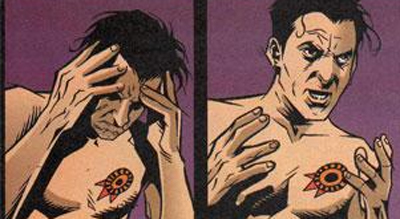
Not quite what I meant when I said he didn't wear a costume...
I am honestly not too sure of what to make of Tony Harris’ artwork. Sometimes it suits the book (and the writing) well, but other times it’s difficult to see what is going on exactly. There are no shortage of well-drawn and memorable sequences (for example the whole of Talking with David, ’95 with David’s Starman uniform the only bit of colour on the panel – until Jack is lit up by his glow – or the sequence between Ted Knight and Dr. Phosphorus is Sins of the Child, where everything is grey except for his skin). Still, it’s a little difficult to make stuff out at times, which can be a bit of a hindrance. That said, the covers for the collection are absolutely stunning and some of the best covers I’ve seen produced.
It is a solid collection – a very solid collection. There are numerous threads hinted at in this volume – a soul-eating poster which formed the basis of The Picture of Dorian Gray; the prophecies of the fortune teller; the Nash-Jack dynamic; the human Starman trapped on an alien world – which won’t be fully developed until further down the line. As a result, it can’t help but feel a little incomplete – as though Robinson is showing us brush strokes, but concealing the bigger picture. I had the luxury of having read the entire Sandman collection before I reviewed the first volume of Gaiman’s magnum opus, so maybe this collection may look better in hindsight.
There’s a lot of groundwork laid down here, so much that a lot of the flow doesn’t seem organic – the story feels like it is being delayed or hampered by it. Over the sixteen issues contained here, there are really only three stories told (ignoring the larger stories that are just beginning to take shape). There’s the fantastic introduction to the characters and the city, the adventures in Turk County and Nash’s revenge for her father’s defeat. They are engaging and interesting stories – to be sure – but they seem to take place at a leisurely pace.
It is a new and refreshing take on the superhero concept. It’s an overarching story which has clearly been carefully planned years in advance. Robinson knows what he’s doing. It’s interesting and intriguing and compelling, but it seems like it is a series which will take a while to fully deliver on that potential.
I’ll be there when it does.
Check out our reviews of James Robinson’s entire run on Starman:
- The Starman Omnibus, Vol. 1
- The Starman Omnibus, Vol. 2
- The Starman Omnibus, Vol. 3
- The Starman Omnibus, Vol. 4
- The Starman Omnibus, Vol. 5
- The Starman Omnibus, Vol. 6
Filed under: Comics | Tagged: comic books, david mckean, dc comics, dc universe, golden age, grant morrison, graphic novel, jack knight, james robinson, omnibus, Opal City, review, sins of the child, starman, starman omnibus, ted knight, tony harris |
















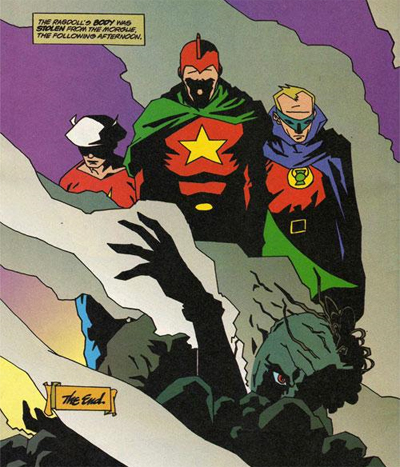
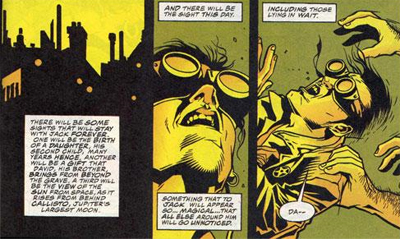

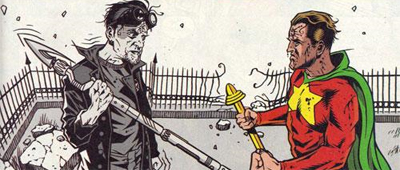





Leave a comment